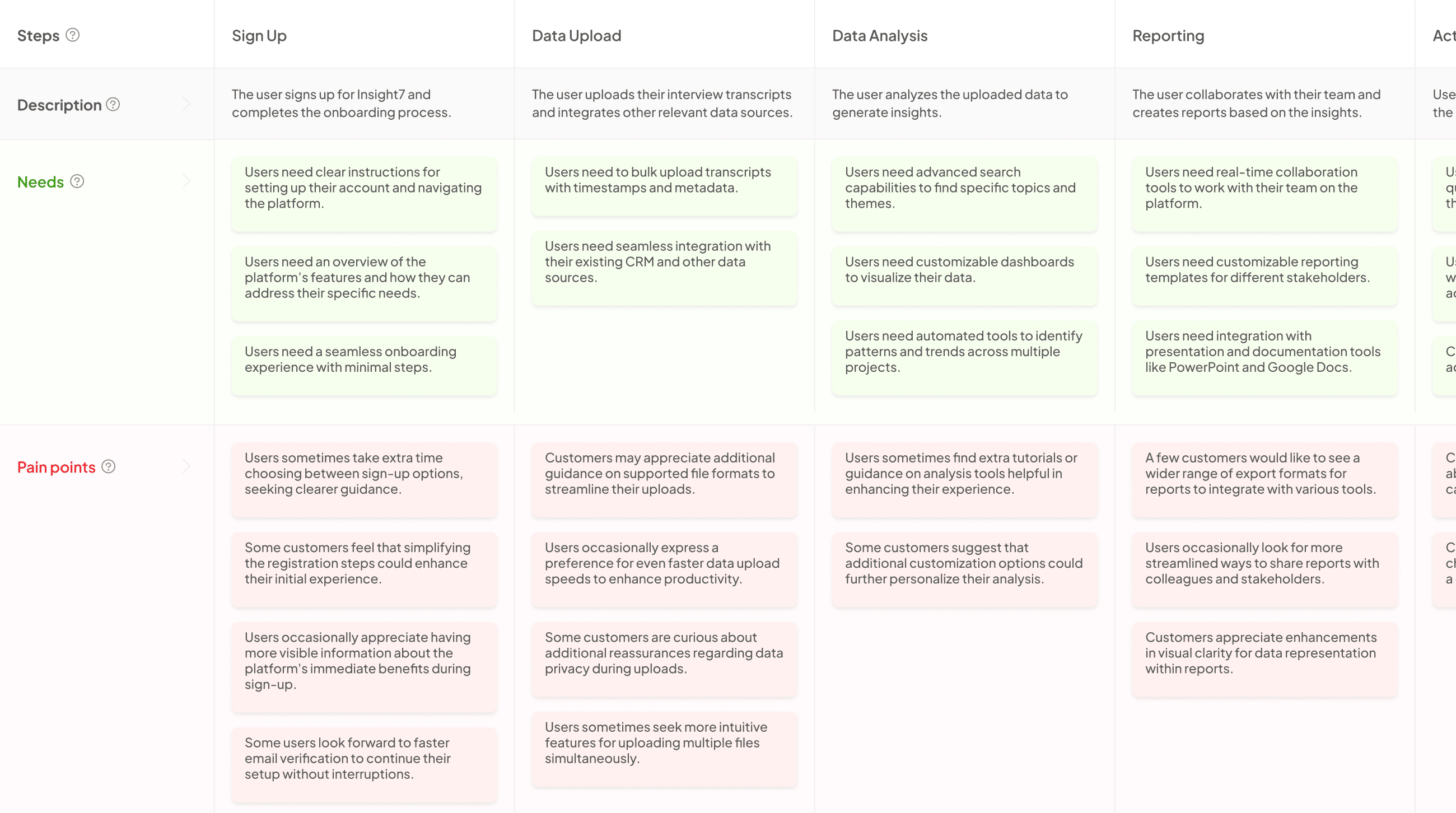7 mapping tools to analyze customer journey
-
Bella Williams
- 10 min read
7 Mapping Tools to Analyze Customer Journey
Understanding the customer journey is crucial for any business aiming to enhance customer experience and drive loyalty. Customer journey mapping provides a visual representation of the steps customers take when interacting with a brand, product, or service. This process helps businesses identify pain points, optimize touchpoints, and ultimately improve customer satisfaction. In this blog post, we will explore seven effective mapping tools that can help you analyze the customer journey, starting with Insight7, a powerful platform designed for qualitative data analysis.
1. Insight7
Sign up for Insight7
Learn more about Insight7
Insight7 is an innovative interview analysis platform that specializes in synthesizing qualitative data at scale. It allows businesses to analyze customer interviews, call recordings, and surveys to uncover actionable insights quickly. With Insight7, you can:
- Transcribe and Analyze: Upload audio or video files and transcribe them with high accuracy (up to 99%).
- Extract Themes and Insights: Automatically pull out key themes, pain points, and customer needs from the data.
- Visualize Data: Create stunning visualizations such as journey maps, mind maps, and reports to present findings effectively.
- Collaborate: Share insights with team members and stakeholders easily, ensuring everyone is aligned on customer needs and experiences.
Generate Journey maps, Mind maps, Bar charts and more from your data in Minutes
Insight7 is particularly beneficial for teams conducting qualitative research, as it streamlines the analysis process and reduces the time spent on manual data synthesis. By leveraging this tool, businesses can gain a deeper understanding of their customers and make informed decisions to enhance their journey.
2. Miro
Miro is a collaborative online whiteboard platform that allows teams to create visual representations of customer journeys. With Miro, you can:
- Create Journey Maps: Use templates to design customer journey maps that illustrate each stage of the customer experience.
- Collaborate in Real-Time: Invite team members to contribute to the journey mapping process, ensuring diverse perspectives are included.
- Integrate with Other Tools: Miro integrates with various project management and communication tools, making it easy to incorporate customer journey mapping into your existing workflows.
3. Lucidchart
Lucidchart is a diagramming application that enables users to create flowcharts, mind maps, and customer journey maps. Key features include:
- Drag-and-Drop Interface: Easily create and customize journey maps using a user-friendly interface.
- Collaboration Tools: Share your diagrams with team members for feedback and collaboration.
- Integration Capabilities: Lucidchart integrates with popular tools like Google Drive, Slack, and Microsoft Office, allowing for seamless collaboration.
4. Smaply
Smaply is a dedicated customer journey mapping tool that focuses on visualizing customer experiences. It offers:
- Journey Mapping Templates: Pre-built templates to help you get started quickly.
- Persona Creation: Develop customer personas to better understand your target audience.
- Touchpoint Analysis: Identify and analyze key touchpoints throughout the customer journey.
Smaply is particularly useful for organizations looking to create detailed and visually appealing customer journey maps.
5. Microsoft Visio
Microsoft Visio is a versatile diagramming tool that can be used to create customer journey maps. Its features include:
- Professional Templates: Access a variety of templates for journey mapping and other diagrams.
- Integration with Microsoft Products: Seamlessly integrate with other Microsoft Office applications, making it easy to share and collaborate.
- Customizable Diagrams: Create tailored journey maps that fit your specific needs and branding.
6. UXPressia
UXPressia is a customer journey mapping tool designed specifically for UX professionals. It provides:
- Interactive Journey Maps: Create interactive maps that allow users to explore different stages of the customer journey.
- Persona Development: Build detailed personas to inform your journey mapping process.
- Export Options: Easily export your journey maps and personas to share with stakeholders.
UXPressia is ideal for teams focused on user experience and looking to create engaging and informative journey maps.
7. Canvanizer
Canvanizer is a simple online tool for creating various canvases, including customer journey maps. Its features include:
- Easy-to-Use Interface: Quickly create journey maps using a straightforward drag-and-drop interface.
- Collaboration Features: Share your canvases with team members for input and feedback.
- Export Options: Export your maps as images or PDFs for easy sharing.
Canvanizer is a great option for teams looking for a quick and easy way to visualize customer journeys without the need for complex software.
Extract insights from Customer & Employee Interviews. At Scale.

Conclusion
Customer journey mapping is an essential practice for businesses aiming to improve customer experience and drive loyalty. By utilizing the right tools, such as Insight7, Miro, Lucidchart, Smaply, Microsoft Visio, UXPressia, and Canvanizer, organizations can effectively analyze and visualize the customer journey, identify pain points, and optimize touchpoints.
Each of these tools offers unique features and capabilities, allowing teams to choose the best fit for their specific needs. By investing in customer journey mapping, businesses can gain valuable insights that lead to enhanced customer satisfaction and long-term success.







